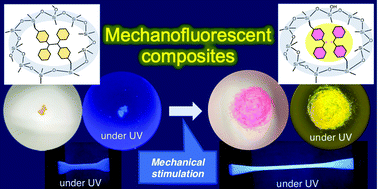Mechanofluorescent polymer/silsesquioxane composites based on tetraarylsuccinonitrile†
Abstract
Mechanofluorescent polymer/silsesquioxane composites with high visibility and outstanding tunable mechanical properties were prepared by introducing tetraarylsuccinonitrile (TASN) derivatives, whose central carbon–carbon bonds can be cleaved upon exposure to mechanical stress, which generates relatively stable pink radicals and yellow-light emission under UV irradiation, via a sol–gel method. The mechanochromic and mechanical properties of the resulting materials were investigated using electron paramagnetic resonance (EPR) measurements and tensile tests, which revealed that these two properties are mutually related and can be easily tuned by changing the feed ratio of the starting materials.

- This article is part of the themed collections: Mechanical Bond and Dynamic Covalent Bond and 2019 Materials Chemistry Frontiers HOT articles


 Please wait while we load your content...
Please wait while we load your content...